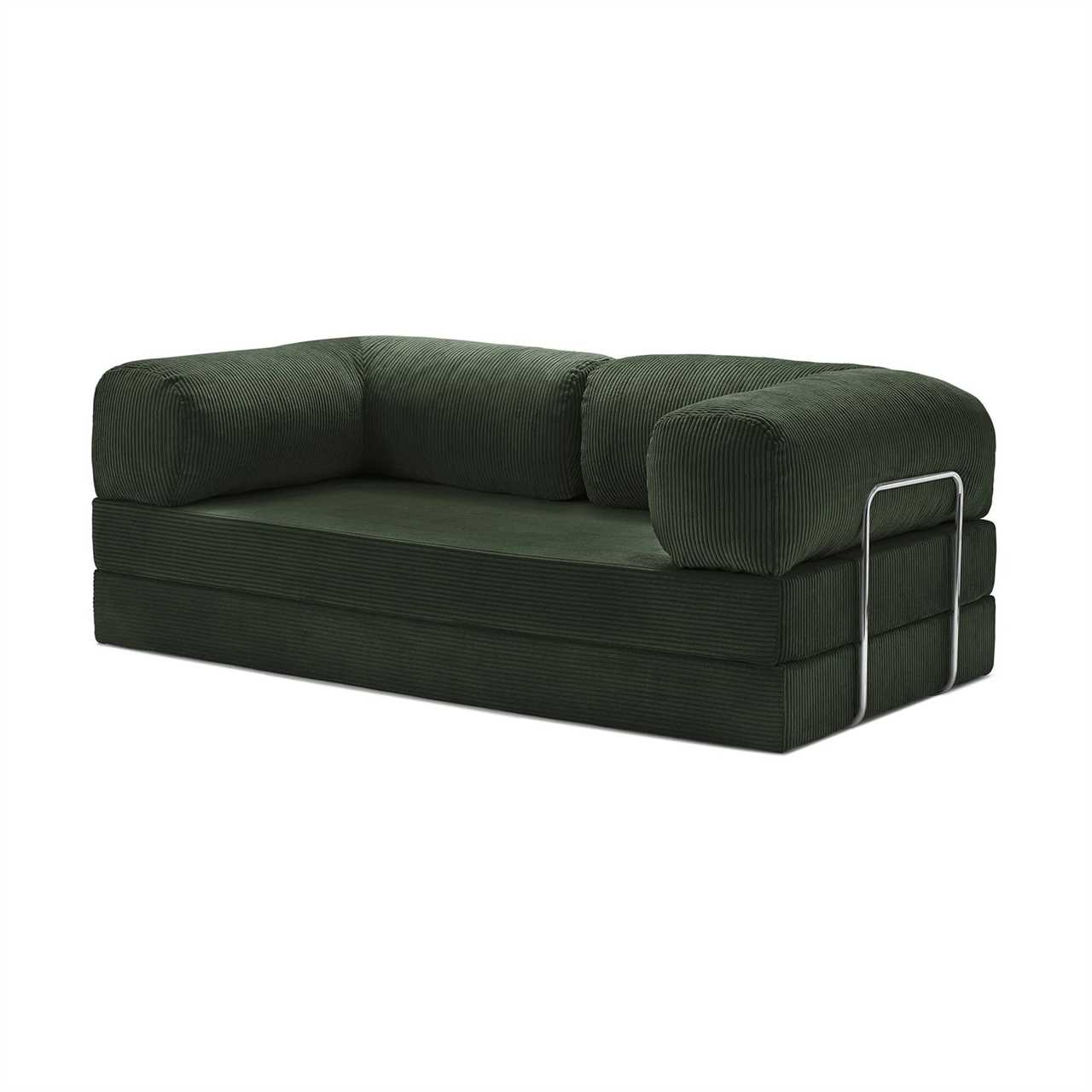OMHU’s TikTok-viral Teddy is the blueprint for a new wave of frameless couches. I tested it and asked the experts what to know before buying one.
Welcome to Someone Buy This!, a monthly shopping column featuring the fun, the frivolous, and the practical from a very discerning shopper.
"Is every sofa bed ugly?" I complained to my boyfriend while scrolling through endless options online. We were preparing to move into a new apartment with a spare bedroom and wanted a transitional piece that could turn it from an office to a guest bedroom when needed.
Sleeper sofas have always struck me as clunky. They don’t often make good sofas, and they’re rarely even remotely comfortable to sleep on. I was looking for something different and had become mildly obsessed with a growing trend: frameless sleeper sofas, or what TikTok users refer to as "boneless" sofas. Made entirely of foam, they’re kind of like Nugget couches but for adults.
Boneless sofas have exploded in popularity within the last two years, especially on TikTok, where users post videos promoting various all-foam couches. The Teddy sofa, made by a Denmark-based brand called OMHU, is at the center of the hype. It launched in 2022, and since then, the rise of TikTok Shop has led to a flood of Teddy "dupes" or, let’s be honest, Teddy rip-offs.
Teddy Sofa by Omhu

TEDDY is a modern take on the classic sofa bed — no legs, no handles, and no complicated mechanics. Just pure comfort and effortless function. He’s soft, supportive, and transforms easily into a spacious bed with a cozy, bear-hug feel.
As of this writing, the top result for "teddy sofa" on TikTok Shop has sold over 6,000 units. That specific couch is not a direct rip-off of the Teddy, but there are plenty that are—and they’re usually priced at $600 or less, which is a little more than a quarter of what the original costs.
Frameless sofas are particularly well-suited for what I call secondary rooms. My home office-slash-guest room is the perfect example. The sleeper sofas I looked at were too big, too expensive, ugly, or all three. A Murphy bed wasn’t an option either. A foam, convertible sofa (like the Teddy and its various cousins) seemed like the best fit. So I set out to explore what was out there, dupes included. Over the course of a few weeks, I looked at dozens of foam sofas, including the Teddy and its many look-alikes. I read product pages, combed through online reviews, and even did a couple of in-store test drives.
The question I kept coming back to was: Are boneless sofas actually good? And are they better or worse than a sofa with a frame?
"It depends on the sofa," says Laura Deutsch, whose company HiLo Brooklyn rehabs vintage sofas. When compared to vintage pieces with solid wood frames, she says, a frameless sofa can’t compete. "But with newer sofas, especially in the mid-range market, the frames are usually made from MDF [medium-density fiberboard] or cheap composite materials that break down quickly," adds Deutsch. "Sometimes even before the foam does."
You’ve read it here on this very website: Most mid-range sofas are not great. The rise of Amazon and other fast-shipping furniture retailers has trained people to expect everything—including big, upholstered pieces—to arrive quickly and cost next to nothing. Flat-pack furniture can absolutely be high-quality, but the $200 sofa from Temu probably isn’t going to last very long.
If you’re shopping for a frameless sofa, the first thing to look at is the materials. Many of the product descriptions I came across were almost comically vague. One listed the sofa’s material as simply "sponge."
Detailed spec pages are a good sign. You may not recognize all the terms, but the more detail you have the more you can Google. I’d think twice about getting a sofa made entirely of memory foam. This material can trap moisture, particularly if it’s resting directly on the floor and not getting ventilation—a bigger risk in humid climates but a risk all the same.
I reached out to several companies who make foam sofas, and OMHU was the only one to entertain my questions. The Teddy sofa has the most detailed spec page of any of the others I looked at, but I still had questions about its "cold foam" material and how it differs from other types of foam. "Cold foam has an open-cell structure that allows air to circulate freely, which helps wick away moisture and dry faster," says Emma Nygård, a product coordinator at OMHU. "In contrast, memory foam tends to trap heat and humidity due to its denser cell structure, making it slower to ventilate." She added that they use a technical fabric on the underside of the sofa to ensure breathability. "The combination of cold foam and technical fabric ensures a drier, more comfortable surface—especially important in multiuse furniture like sofa beds," says Nygård.
The OMHU team told me the Teddy is made of mattress-grade T30 foam with an Indentation Load Deflection (ILD) of 45. This means the foam is high density and quite firm. When I asked Laura Deutscht about the differences between upholstery foam and mattress foam, she said the use cases are different. "For mattresses, T30 foam (which is around 1.8 pounds per cubic foot) is considered high-density because it’s meant to compress and contour to your body while lying down," she said. When you translate that same foam to a seating context, it’s a different story." T30 is the absolute minimum-density foam Deutsch says she would consider for seating. "Sofas need foam that holds up under concentrated pressure—like your full body weight in one small spot, for hours at a time."
Deutsch says that for a sofa to hold up over time, you need high-density foam, ideally 2.2 pounds per cubic foot or more, combined with a firm base that keeps it from going flat or losing support. She’s not convinced that the T30 foam can compete with higher-density upholstery foam on a solid wood frame. "It’s doing a job it was never meant to do," she says.
I still think that a foam sofa is right for certain use cases. If you’re curious about boneless sofas, the Teddy is your best bet. This is especially true if you need it to double as a guest bed. If you remove the back cushions, you’ve got a sleeping surface the size of a twin XL mattress. Flip the seat out and you’ll have a king-size bed. If you get a pair of foldable twin bed frames, you can elevate it and make it feel more like a real bed. I’m not sold on the Teddy as my main couch, but that has more to do with how it looks in my living room than how it performs. It’s the perfect solution for my office and guest space.
While the prices of Teddy dupes are very tempting, it’s safe to say a $300 "sponge" couch is not going to last you very long. If your budget allows, buy the original. You’ll get a warranty, actual product support, and the ability to add or swap pieces, like a sectional, as your space evolves. You can even get a second cover in a different color. You don’t have to commit!
Another point in the Teddy’s favor is that, unlike a lot of other frameless sofas, it doesn’t need to lean against a wall for support. Even without a frame, it holds its shape. I tested this by overstaying my welcome at Teak in New York, OMHU’s only U.S. stockist. I sprawled out on the sofa, which was floated off the wall in the showroom, and leaned hard into the back cushions. I was fully prepared for it to shift. It didn’t!
In the end, the Teddy isn’t perfect (what couch is?), but it does seem to solve a problem that a lot of people run into. It offers a way to turn an office or spare room into something more flexible, without dominating the space or clashing with everything else in it. And maybe that’s the real appeal of a boneless sofa—not that it’s going to be the most durable piece of furniture you ever buy, but that it meets a very specific kind of need. It’s transitional, in both form and purpose. For a lot of people, that’s exactly the point.
We love the products we feature and hope you do, too. If you buy something through a link on the site, we may earn an affiliate commission.
Related Reading:
Sofa Sagas: Every Couch Search Is Like a Love Story
Why Are (Most) Sofas So Bad?
Read More
By: Veronica de Souza
Title: Are "Boneless" Sleeper Sofas Worth the Hype?
Sourced From: www.dwell.com/article/omhu-teddy-sofa-review-c8b2f62f
Published Date: Wed, 20 Aug 2025 13:42:04 GMT
Did you miss our previous article...
https://trendinginbusiness.business/real-estate/mortgage-applications-shrink-as-va-loan-demand-declines
.png)





